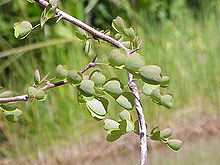Haematoxylum campechianum
- Logwood redirects here. It may also refer to members of the genus Xylosma, which is part of the willow family, Salicaceae.
| Logwood | |
|---|---|

| |
| Scientific classification | |
| Kingdom: | |
| (unranked): | |
| (unranked): | |
| (unranked): | |
| Order: | |
| Family: | |
| Genus: | |
| Species: | H. campechianum
|
| Binomial name | |
| Haematoxylum campechianum | |
Haematoxylum campechianum (logwood or bloodwood tree) is a species of flowering tree in the legume family, Fabaceae, that is native to southern Mexico and northern Central America.[1] The tree was of great economic importance from the 17th century to the 19th century, when it was commonly logged and exported to Europe for use in dyeing fabrics.[2] The modern nation of Belize developed from 17th and 18th-century logging camps established by the English. The tree's scientific name means "bloodwood" (haima being Greek for blood and xylon for wood).
Uses
Logwood was used for a long time as a natural source of dye. It remains an important source of haematoxylin, which is used in histology for staining. The bark and leaves are also used in various medical applications. In its time, logwood was considered a versatile dye, and was widely used on textiles and also for paper.[3]
The extract was once used as a pH indicator. Brownish when neutral, it becomes yellow-reddish under acidic conditions and purple when alkaline.[3] In a small demonstrative experiment, if two drops, one of concentrated ammonia and one of logwood extract, are placed close enough the NH3 vapours will change the color of the extract to a purple shade.[4]
References
- ^ "Haematoxylum campechianum". Germplasm Resources Information Network. United States Department of Agriculture. Retrieved 2009-01-27.
- ^ Hofenk de Graff, Judith H. (2004). The Colourful Past: Origins, Chemistry and Identification of Natural Dyestuffs. London: Archetype Books. p. 235. ISBN 1873132131.
- ^ a b Hammeke, Erin (2004). "Logwood Dye on Paper" (PDF). University of Texas at Austin. Retrieved 2008-07-05.
- ^ Chemical Recreations, John Joseph Griffin, 1834, p. 279
External links
- Wayne's Word: "Logwood and Brazilwood, Trees That Spawned 2 Nations"
 Media related to Haematoxylum campechianum at Wikimedia Commons
Media related to Haematoxylum campechianum at Wikimedia Commons Data related to Haematoxylum campechianum at Wikispecies
Data related to Haematoxylum campechianum at Wikispecies
- Trees of Central America
- Trees of Southern Mexico
- Trees of Belize
- Trees of Campeche
- Trees of Chiapas
- Trees of Guatemala
- Trees of Quintana Roo
- Trees of the Yucatán Peninsula
- Medicinal plants of Central America
- Medicinal plants of South America
- Plant dyes
- Crops originating from Mexico
- Plants described in 1753
- Caesalpinioideae stubs
- Medicinal plant stubs



